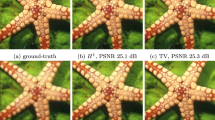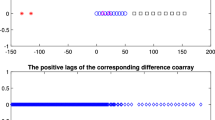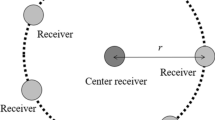Abstract
In this paper, the problem of passive direction finding is addressed using an acoustic vector sensor array (AVS), which may be deployed either in free space or near a reflecting boundary. Building upon the \(4 \times 1\) vector field measured by an AVS, the particle-velocity coarray augmentation (PVCA) is proposed to admit the underdetermined direction finding using the spatial difference coarray derived from the vectorization of the array covariance matrix. Unlike the widely used spatial coarray Toeplitz recovery technique, the PVCA is applicable to arbitrary array geometries and imposes no reduction of the spatial difference coarray aperture. For the array located at or near a reflecting boundary, the PVCA allows resolving up to 13 sources, while for the array located in free space, the PVCA can identify 9 sources at most. By applying to the systematically designed nonuniform arrays, such as coprime arrays and nested arrays, the PVCA can be coupled with the spatial smoothing technique to get the number of resolvable sources multiplied. Finally, the effectiveness of the PVCA is verified by numerical simulations.







Similar content being viewed by others
Data Availability Statement
The data used to support the findings of this study are available from the corresponding author upon request.
References
H.-E. de Bree, J. Wind, P. de Theije, Detection, localization and tracking of aircraft using acoustic vector sensors, in International Noise 2011 Proceedings, Osaka, pp. 1112–1116 (2011)
H.-E. De Bree, J. W. Wind, The acoustic vector sensor: A versatile battlefield acoustics sensor. Ground/Air Multisensor Interoperability, Integr., Netw. Persistent ISR II, Int. Soc. Optics Photon. 80470C (2011)
L.M. Brekhovskikh, Waves in Layered Media, 2nd edn. (Academic, New York, 1980)
Y.-M. Chen, On spatial smoothing for two-dimensional direction-of arrival estimation of coherent signals. IEEE Trans. Signal Process. 45(7), 1689–1696 (1997)
H. Chen, J. Zhao, Wideband MVDR beamforming for acoustic vector sensor linear array. IEE Proc. Radar Sonar Navig. 151(3), 158–162 (2004)
C.W. Clark, M.L. Tasker, M. Ferguson, J.P. Hartley, I. Fletcher, A. Whitehead, A.A. Duff, J.F. Appelbee, C. Pickton, J. Spink, C. MacDuff-Duncan, S.J. Knight, A.H. Walls, A. Onder, J. Urbanus, I. Buchanan, in Proceedings of SPE/UKOOA European Environment Conference Aberdeen, U.K., Monitoring the occurrence of large whales off north and west Scotland using passive acoustic arrays (1997), pp. 23–29
N.R. Goodman, Statistical analysis based on a certain multivariate complex Gaussian distribution (An introduction). Ann. Math. Stat. 34(1), 152–177 (1963)
K. Han, A. Nehorai, Nested vector-sensor array processing via tensor modeling. IEEE Trans. Signal Process. 62(10), 2542–2553 (2014)
M. Hawkes, A. Nehorai, Effects of sensor placement on acoustic vector-sensor array performance. IEEE J. Oceanic Eng. 24(1), 33–40 (1999)
M. Hawkes, A. Nehorai, Battlefield target localization using acoustic vector sensors and distributed processing, in Proceedings of Meeting IRIS Specialty Group Battlefield Acoustics Seismics, Laurel (1999), pp. 111–128
M. Hawkes, A. Nehorai, Acoustic vector-sensor processing in the presence of a reflecting boundary. IEEE Trans. Signal Process. 48(11), 2981–2993 (2000)
J. He, L. Li, T. Shu, Sparse nested arrays with spatially spread square acoustic vector sensors for high-accuracy underdetermined direction finding. IEEE Trans. Aerosp. Electron. Syst. 57(4), 2324–2336 (2021)
J. He, L. Li, T. Shu, Sparse nested arrays with spatially spread orthogonal dipoles: high accuracy passive direction finding with less mutual coupling. IEEE Trans. Aerosp. Electron. 57(4), 2337–2345 (2021)
J. He, Z. Liu, Two-dimensional direction finding of acoustic sources by a vector sensor array using the propagator method. Signal Process. 88(10), 2492–2499 (2008)
J. He, Z. Liu, Efficient underwater two-dimensional coherent source localization with linear vector hydrophone array. Signal Process. 89, 1715–1722 (2009)
J. He, Z. Zhang, C. Gu, T. Shu, W. Yu, Cumulant-based 2-D direction estimation using an acoustic vector sensor array. IEEE Trans. Aerosp. Electron. Syst. 56(2), 956–971 (2020)
C. Khatri, C.R. Rao, Solutions to some functional equations and their applications to characterization of probability distributions. J. Stat. A. 30(2), 167–180 (1968)
J. Li, M. Hodgson, Development and evaluation of equivalent-fluid approximations for sea-bottom sound reflection. Canad. Acoust. 26, 3–11 (1998)
L. Liang, Y. Shi, Y. Shi, Z. Bai, W. He, Two-dimensional DOA estimation method of acoustic vector sensor array based on sparse recovery. Digital Signal Process. 120, 103294 (2022)
C.L. Liu, P.P. Vaidyanathan, Remarks on the spatial smoothing step in coarray MUSIC. IEEE Signal Process. Lett. 22(9), 1438–1442 (2015)
K.W. Lo, Flight parameter estimation using instantaneous frequency and direction of arrival measurements from a single acoustic sensor node. J. Acoust. Soc. Am. 141(3), 1332–1348 (2017)
A. Moffet, Minimum-redundancy linear arrays. IEEE Trans. Antennas Propag. 16(2), 172–175 (1968)
A. Nehorai, E. Paldi, Acoustic vector-sensor array processing. IEEE Trans. Signal Process. 42(9), 2481–2491 (1994)
P. Pal, P.P. Vaidyanathan, Nested array: a novel approach to array processing with enhanced degrees of freedom. IEEE Trans. Signal Process. 58(8), 4167–4181 (2010)
P. Palanisamy, N. Kalyanasundaram, P.M. Swetha, Two dimensional DOA estimation of coherent signals using acoustic vector sensor array. Signal Process. 92(1), 19–28 (2012)
S.U. Pillai, Y. Bar-Ness, F. Haber, A new approach to array geometry for improved spatial spectrum estimation. Proc. IEEE 73(10), 1522–1524 (1985)
S. Qin, Y. Zhang, M. Amin, Generalized coprime array configurations for direction-of-arrival estimation. IEEE Trans. Signal Process. 63(6), 1377–1390 (2015)
R. Roy, T. Kailath, ESPRIT-estimation of signal parameters via rotational invariance techniques. IEEE Trans. Acoust. Speech Signal Process. 37(7), 984-995 (1989)
R.O. Schmidt, Multiple emitter location and signal parameter estimation. IEEE Trans. Antennas Propag. 34(3), 276–280 (1986)
S.G. Shi, Y. Li, Z.R. Zhu, J. Shi, Real-valued robust DOA estimation method for uniform circular acoustic vector sensor arrays based on worstcase performance optimization. Appl. Acoust. 148, 495–502 (2019)
A. Song, A. Abdi, M. Badiey, P. Hursky, Experimental demonstration of underwater acoustic communication by vector sensors. IEEE J. Oceanic Eng. 36(3), 454–461 (2011)
J. Tao, W. Chang, W. Cui, Vector field smoothing for DOA estimation of coherent underwater acoustic signals in presence of a reflecting boundary. IEEE Sensors J. 7(8), 1152–1158 (2007)
P.P. Vaidyanathan, P. Pal, Sparse sensing with co-prime samplers and arrays. IEEE Trans. Signal Process. 59(2), 573–586 (2011)
A. Weiss, Blind Direction-of-Arrival estimation in acoustic vector-sensor arrays via tensor decomposition and Kullback-leibler divergence covariance fitting. IEEE Trans. Signal Process. 69, 531–545 (2021)
K.T. Wong, M.D. Zoltowski, Extended-aperture underwater acoustic multi-source azimuth/elevation direction-finding using uniformly but sparsely spaced vector hydrophones. IEEE J. Ocean. Eng. 22(4), 659–672 (1997)
K.T. Wong, M.D. Zoltowski, Root-MUSIC-based azimuth-elevation angle-of-arrival estimation with uniformly spaced but arbitrarily oriented velocity hydrophones. IEEE Trans. Signal Process. 47(12), 3250–260 (1999)
Y. Xu, Z. Liu, Frequency-azimuth-elevation determination with a single acoustic vector-sensor involved in a reflecting boundary. Circuits Syst. Signal Process. 26, 875–895 (2007)
D.R. Yntema, W. Druyvesteyn, M. Elwenspoek, A four particle velocity sensor device. J. Acoust. Soc. Am. 119(2), 943–951 (2006)
C. Zhou, Y. Gu, X. Fan, Z. Shi, G. Mao, Y.D. Zhang, Direction-of-arrival estimation for coprime array via virtual array interpolation. IEEE Trans. Signal Process. 66(22), 5956–5971 (2018)
M.D. Zoltowski, S.D. Silverstein, C.P. Mathews, Beamspace Root-MUSIC for minimum redundancy linear arrays. IEEE Trans. Signal Process. 41(7), 2502–2507 (1993)
N. Zou, A. Nehorai, Circular acoustic vector-sensor array for mode beamforming. IEEE Trans. Signal Process. 57(8), 3041–3052 (2009)
Author information
Authors and Affiliations
Corresponding author
Ethics declarations
Conflict of interest
We declare that we have no financial and personal relationships with other people or organizations that can inappropriately influence our work, and there is no professional or other personal interest of any nature or kind in any product, service, and/or company that could be construed as influencing the position presented in, or the review of, the manuscript entitled, “Particle–Velocity Coarray Augmentation For Direction Finding with Acoustic Vector Sensors.”
Additional information
Publisher's Note
Springer Nature remains neutral with regard to jurisdictional claims in published maps and institutional affiliations.
This work was supported by the National Natural Science Foundation of China under grant 61771302.
Appendices
Appendix A: Derivation of the Matrix \({{\varvec{P}}}\) in (7)
Define a \(PQ \times PQ\) matrix \({{\varvec{U}}}_{P \times Q}\) as
where \({{\varvec{E}}}_{pq}\) is a \(P \times Q\) matrix with all zeros except a 1 at the (p, q)th position and \({{\varvec{F}}}_{qp}\) is a \(Q \times P\) matrix with all zeros except a 1 at the (q, p)th position.
Using the following three matrix prosperities given in [17]
we have
and
Let \({{\varvec{P}}} = ({{\varvec{I}}}_4 \otimes {{\varvec{U}}}_{4 \times L^2}) ({{\varvec{U}}}_{4 \times L} \otimes {{\varvec{I}}}_{4L})\). The relationship (7) is established.
Appendix B: Proof of Theorem 1
The rank of \(\bar{{\varvec{C}}}\) depends on the linear dependence of the particle-velocity coarray steering vector \(\bar{{\varvec{c}}}(\theta , \phi ) \triangleq {{\varvec{c}}}^*(\theta , \phi ) \otimes {{\varvec{c}}}(\theta , \phi )\). In fact, the ith element of \(\bar{{\varvec{c}}}(\theta , \phi )\), denoted by \({\bar{c}}_i\), is the product of the mth element of \({{\varvec{c}}}^*(\theta , \phi )\) and the nth element of \({{\varvec{c}}}(\theta , \phi )\), where the relationship between m, n, and i is
where “eps” represents the floating-point relative accuracy, which is used to ensure the values of n are within 1 to 4. With the foregoing notations, the 16 elements of \(\bar{{\varvec{c}}}\), listed in Table 4, can be computed, where \(\rho \triangleq \mathcal{R}(\theta ) e^{-j \vartheta }\).
From Table 4, we have the following two cases:
-
(i)
For \(\mathcal{R}(\theta ) \ne 0, \pm 1, \forall \theta \), \({\bar{c}}_5 = {\bar{c}}_2\), \({\bar{c}}_9 = {\bar{c}}_3\), and \({\bar{c}}_{10} = {\bar{c}}_7\). Therefore, the 5th, 9th, and 10th rows of \({\bar{{\varvec{C}}}}\) are linearly dependent on the remaining 13 rows. For sources of arbitrary but different directions, the rank of \({\bar{{\varvec{C}}}}\) is up to 13 at most.
-
(ii)
For \(\mathcal{R}(\theta ) = 0, \forall \theta \), \({\bar{c}}_5 = {\bar{c}}_2\), \({\bar{c}}_9 = {\bar{c}}_3\), \({\bar{c}}_{10} = {\bar{c}}_7\), \({\bar{c}}_{13} = {\bar{c}}_4\), \({\bar{c}}_{14} = {\bar{c}}_8\), \({\bar{c}}_{15} = {\bar{c}}_{12}\), and \({\bar{c}}_{16} = {\bar{c}}_{1} - {\bar{c}}_{6} - {\bar{c}}_{11}\). Therefore, the 5th, 9th, 10th, and 13-16th rows of \({\bar{{\varvec{C}}}}\) are linearly dependent on the remaining 9 rows. For sources of arbitrary but different directions, the rank of \({\bar{{\varvec{C}}}}\) is up to 9 at most.
Based on the above (i) and (ii), the results in Theorem 1 are established.
Rights and permissions
Springer Nature or its licensor (e.g. a society or other partner) holds exclusive rights to this article under a publishing agreement with the author(s) or other rightsholder(s); author self-archiving of the accepted manuscript version of this article is solely governed by the terms of such publishing agreement and applicable law.
About this article
Cite this article
Shu, T., He, J. & Truong, TK. Particle-Velocity Coarray Augmentation for Direction Finding with Acoustic Vector Sensors. Circuits Syst Signal Process 42, 3072–3093 (2023). https://doi.org/10.1007/s00034-022-02269-z
Received:
Revised:
Accepted:
Published:
Issue Date:
DOI: https://doi.org/10.1007/s00034-022-02269-z




